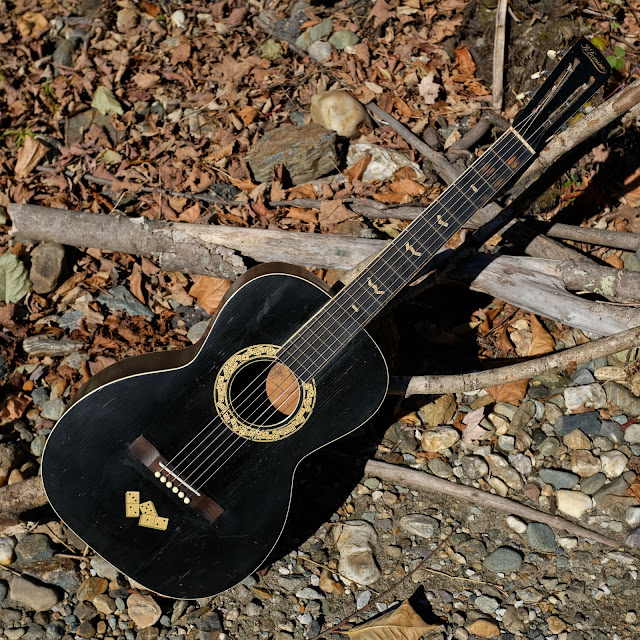1930s Regal LeDomino 0-Size Flattop Guitar
Well, that's it for the pair (click to see the other)! I've had various parties interested in these LeDomino guitars for years, now, though shop-time has always escaped them. This one is almost identical to its stablemate except that the decals are a little more yellowed, it has slightly more playwear, the main ladder bracing is a little more slanted (hence "transverse ladder bracing"), and the top is cut a little thinner. These changes in the design yield a mellower, warmer, fuller sound with perhaps slightly less punch -- and the lighter build to the top means I'd suggest tension in the 52w-11s range for standard-tuning use to keep the instrument healthy.
Work included a neck reset, new rosewood bridge (the original was split), new bone saddle, fret seating and level/dress, side dots install, replacement (parts-bin) tuners, a new compensated bone saddle, parts-bin scrounging for a set of period celluloid pins and a plastic endpin, general cleaning, and a good setup. It plays bang-on with 3/32" EA and 1/16" DGBE action at the 12th fret and has a good, tall saddle. The neck is straight and the frets have plenty of life left. Strings are a custom set gauged 52w, 38w, 28w, 20w, 16, 12. This is like "11s" with the EB highs jacked-up one gauge for a thicker tone.
Specs are: 24 5/8" scale, 1 13/16" nut width, 1 9/16" string spacing at the nut, 2 1/8" spacing at the bridge, 13 1/2" lower bout, 9 3/4" upper bout, and 4" depth at the endblock. The neck has a flat board profile and medium-big, soft C/V rear profile.
Materials are: solid spruce top, solid birch back and sides, poplar neck, ebonized-maple fretboard, rosewood bridge, bone nut and saddle, celluloid bridge pins, plastic endpin.
Wear and tear notes: there are no real cracks in the instrument except for a couple of tiny 1/2" ones on the sides, but parts of the top have raised graining that look a little like hairlines. There's use-wear throughout (including minor scratching all over) and some old glue residue below the bridge on the top from an older bridge reglue job, but for an old catalog guitar, it looks pretty dang good.
The original frets are smallish and brass, but leveled/dressed just fine.
The top on this guitar is nice and flat, so I figured a straight-cut bridge would be good-enough support on it vs. a belly-bridge.
The tuners are '60s-style Japanese tuners from my parts-bins, but they were the closest to the very-damaged originals in looks. They work about the same as period tuners, too -- decent but not like a modern 18:1 Grover Sta-Tite.




















Comments